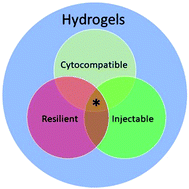In situ-forming, mechanically resilient hydrogels for cell delivery
Abstract
Injectable, in situ-forming hydrogels can improve cell delivery in tissue engineering applications by facilitating minimally invasive delivery to irregular defect sites and improving cell retention and survival. Tissues targeted for cell delivery often undergo diverse mechanical loading including high stress, high strain, and repetitive loading conditions. This review focuses on the development of hydrogel systems that meet the requirements of mechanical resiliency, cytocompatibility, and injectability for such applications. First, we describe the most important design considerations for maintaining the viability and function of encapsulated cells, for reproducing the target tissue morphology, and for achieving degradation profiles that facilitate tissue replacement. Models describing the relationships between hydrogel structure and mechanical properties are described, focusing on design principles necessary for producing mechanically resilient hydrogels. The advantages and limitations of current strategies for preparing cytocompatible, injectable, and mechanically resilient hydrogels are reviewed, including double networks, nanocomposites, and high molecular weight amphiphilic copolymer networks. Finally, challenges and opportunities are outlined to guide future research in this developing field.

- This article is part of the themed collection: Recent Review Articles


 Please wait while we load your content...
Please wait while we load your content...